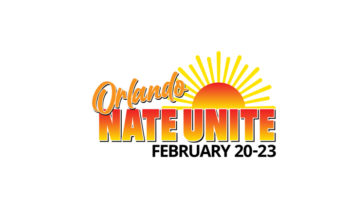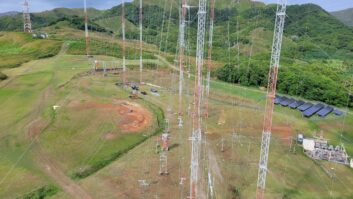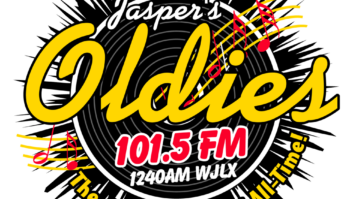If you’ve ever driven the Schuylkill Expressway, Interstate 76 into Philadelphia, especially after dark, you’ve seen them: eight tall towers, beacons flashing, all within a mile or so of each other on a rise just above the Schuylkill River.
“Those red beacons would still be blinking,” recalls radio programmer Clarke Ingram of the early-morning bus rides he would take from Pittsburgh to Atlantic City in the late 1960s. “As a wide-eyed kid of eight or nine, I viewed those tall towers with awe.”
(click thumbnail)From left: WGTW(TV); the old WCAU(TV) tower; the new Philadelphia digital TV tower; and the Banks, Fox and Gross towers.
Philadelphia’s radio community knows those towers as the “Roxborough Tower Farm” – and more than a few engineers in the City of Brotherly Love themselves view the site with something approaching awe.
“It’s not the highest point in the city, by any means,” said Mark Humphrey, director of engineering for Radio One in Philadelphia and the unofficial historian of the Roxborough farm. “But it does have the ability to look into the Schuylkill Valley; and with a tower height of 700 feet, you can see into the Delaware Valley as far as you need to.”
“It’s not unusual to see towers that spread out, or short towers clumped together,” Humphrey reflected, “but when you see so many tall towers within a half-mile of each other, that’s really something.”
A half century ago…
Yet for all Roxborough’s prominence in today’s Philadelphia broadcast scene — it’s now home to nearly all the market’s FM and TV signals — it’s not the birthplace of TV or FM in the city.
That honor goes to another Philadelphia neighborhood a few miles to the north called Wyndmoor, where Philco put WPTZ(TV) Channel 3 on the air in 1941. WPTZ replaced an experimental signal, W3XE, that had already been broadcasting for a decade by then.
So it fell to the city’s second TV station, WFIL(TV) Channel 6, to inaugurate the use of Roxborough for broadcasting. In 1947, WFIL put up a 600-foot guyed tower on an open piece of land off Ridge Pike, and an era had begun.
Just down the street, WFLN(FM) at 95.7 MHz built its own self-supporting tower and signed on as the city’s first independent FM station the same year. Roxborough was off and running.
By the mid-’50s, Roxborough was already becoming the site of choice for FM and TV. WCAU(TV) Channel 10, which had been using the landmark Art Deco PSFS Building in Center City Philadelphia, needed a taller tower; and because Philadelphia limited downtown buildings to the height of William Penn’s statue atop City Hall, that meant moving to a tower out of Center City, which meant Roxborough.
The Philadelphia Bulletin, which sold WCAU(AM-FM-TV) to CBS in 1958, quickly acquired another FM construction permit and used the new 1200-foot Dresser-Crane WCAU(FM-TV) tower on Domino Lane for its new WPBS(FM) at 98.9 – and WPBS’ all-important Muzak subcarrier franchise – as well.
WPBS even built studios on Domino Lane that are still in use today by its successor, WUSL(FM).
Channel 3 left its historic site in Wyndmoor in the late 1950s, teaming up with WFIL(TV) to build a joint tower at Roxborough. The 1116-foot tower, which went up in 1957, dramatically expanded the reach of Philadelphia’s TV signals, spelling the end of attempts to build local UHF stations in surrounding communities like Reading and Allentown.
Channel 6’s old tower remained standing, continuing in use for WFIL(FM) at 102.1, now WIOQ, which is still there today.
UHF brings more steel
Roxborough kept sprouting in the ’60s, as the advent of UHF TV meant a need for more thousand-foot-plus towers.
The “Banks Tower” on Domino Lane went up across from WCAU in the middle of the decade, named for William and Dolly Banks, who owned both WWDB(FM) at 96.5 and WPHL(TV) Channel 17, which had signed on from Wyndmoor but soon moved to Roxborough. Nearby, Irwin and William Fox built the “Fox Tower” for their WIBF(TV) Channel 29, while Kaiser Broadcasting leased land from Channel 6 to built a tower for WKBS(TV) Channel 48.
In 1979, the UHF dial filled out when Bill Gross built a tower for WWSG(TV) Channel 57 on a Paoli Avenue property that Storer Broadcasting had purchased 20 years earlier for an unsuccessful attempt to move its WVUE(TV) Channel 12 into Philadelphia from Wilmington, Del.
The Banks Tower became the home of one of the first master FM antennas in the country in the early 1970s, thanks to WPHL engineer Len Stevens.
(click thumbnail)Mark Humphrey of Radio One took this photo of WPSG(TV)’s antenna being airlifted to the Gross tower. The FM tower for WMGK/WMWX is attached to the base. Another tower is at left.
“He built a non-directional two-layer ERI cogwheel and installed a combiner for three stations,” Humphrey recalled. WMGK(FM) at 102.9; WDVR(FM) at 101.1, now WBEB; and WRCP(FM) at 104.5, now WSNI all moved to the master site and joined the tall-tower club at that point.
Later, when the Channel 57 tower went up, 101.1 and 102.9 would move there, joined by WXTU(FM) 92.5, which moved to Roxborough from suburban Norristown; meanwhile, WYSP(FM) 94.1 moved from the old Channel 6 tower to the Banks tower around the same time.
Now, stir in a three-tower AM
WRCP’s AM signal on 1540 kHz also was calling Roxborough home by then.
“That was originally a one-kilowatt nondirectional daytimer somewhere in New Jersey,” said Humphrey. With a CP in hand to go to 50 kW, WRCP needed somewhere to put three towers.
“It was probably easy to put a tower there,” Humphrey surmises about the decision to add an AM signal to the FM and TV facilities at Roxborough.
Whatever the reason, the existence of all that medium-wave RF amidst the big TV and FM sticks posed a challenge for both sides, with extra shielding a common feature at the tall towers – and, legend has it, no end of trouble getting the AM directional array to tune up properly.
RF isn’t the only headache at Roxborough. Engineers there also had to deal with a city trash transfer station and incinerator that operated for decades on Domino Lane, right next door to the Fox tower. While the city wasn’t a bad neighbor – it even leased land for the construction of the Fox tower and allowed one of that tower’s guy wires to go across the street onto its property – the incinerator and the transmitters never got along well.
“It was a real maintenance nightmare for most of the engineers because soot would get sucked into the transmitters,” Humphrey remembers. “It would cause corrosion inside the transmitters, and the guy wires had to be greased regularly.”
The incinerator is long gone, but the transfer station is still in business on Domino Lane – surrounded by some tall new neighbors.
A new era of building
With the advent of digital TV in the late 1990s, Roxborough gained two more tall towers.
(click thumbnail)On the left is the WGTW(TV)/WXPN/WPLY tower and on the right is the old ‘square cross-section’ WUSL/WIOQ tower, first built for WPVI(TV).
Channels 3 and 6 put up the tallest tower yet, at 1,276 feet, with a candelabra for both stations’ DTV signals. Meanwhile, American Tower, thwarted by neighborhood opposition to its plan to put up a new tower northwest of the existing cluster, reached a deal with channel 10, by then owned by NBC, to build a new tower on the WCAU property on Domino Lane, replacing the old Channel 10 tower. The latter was shortened for use as a standby site.
The new 1,256-foot tower, which went up in 1998, incorporates space for FM tenants, with a four-bay ERI cogwheel panel array and a combiner system. So far, Infinity’s WOGL(FM) at 98.1, an historic occupant of the Channel 10 tower dating to its days as WCAU(FM), is the only tenant there.
American Tower is now the biggest operator in the tower farm; in addition to the new Channel 10 tower, it owns the Banks (Channel 17) tower, the Gross (Channel 57) tower and the old WFLN(FM) tower.
And just this year, Roxborough landed still another big FM signal. Radio One’s WPLY(FM) at 100.3, licensed to Media, had long been hampered by a tower site far out of town in Newtown Square, Pa. In early May, “Y100” joined its sister station WPHI(FM) 103.9 at Roxborough, operating from a unique seven-panel ERI cogwheel panel antenna on the Channel 48 tower.
Still growing
With eight towers over 1,000 feet; several shorter towers including the original WFLN(FM) self-supporting tower, now being used by Fox’s WTXF(DT); 10 full-power analog TV signals; 11 DTVs; 16 FMs and, yes, a 50-kW directional AM, Roxborough remains one of the nation’s most concentrated broadcast sites – nestled in a corner of Philadelphia that feels as though it should be far outside the city limits, even though it’s just a few miles from City Hall.
“You drive back in that corner of Philadelphia and you’d think you were in (very rural) Potter County,” Humphrey said. “It’s very rural, and people like it that way.”















